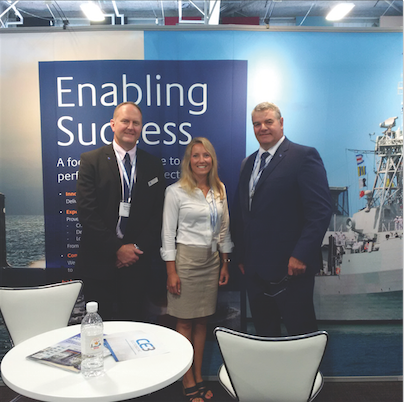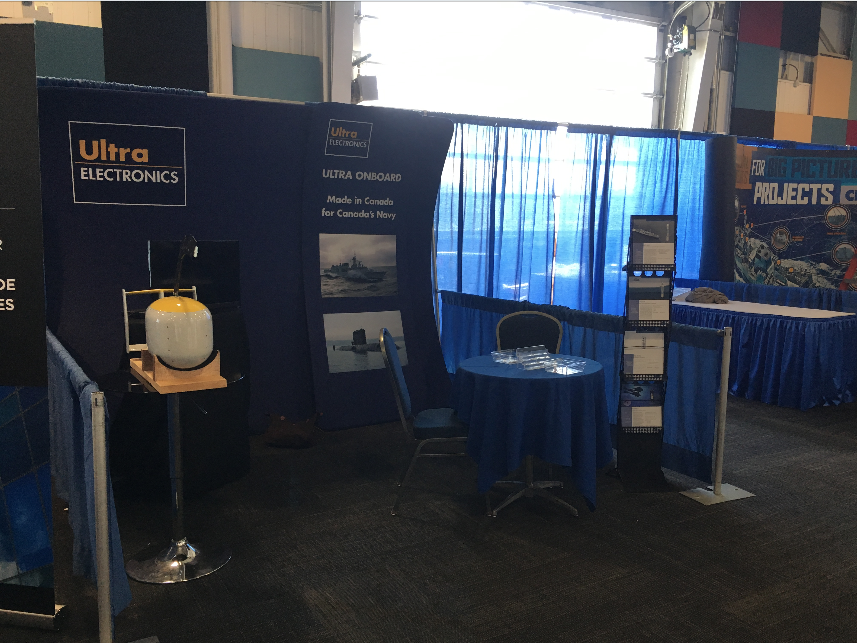By James G. Scott
The annual Canadian Defence Security and Aerospace Exhibition Atlantic (DEFSEC) is the second largest show of its kind in Canada and well reflects the importance of military hardware and software on the maritime economy. Evolving and growing from the ground show portion of the Nova Scotia International Airshow, DEFSEC has become the see-and-be-seen event for naval personnel and their industrial counterparts. Given the tens of billions of dollars expected to be invested in new ships and their sensor suites in coming decades, this show would seem to have established a permanent place on senior officials’ calendars and a permanent home in downtown Halifax.
The Cunard Centre on the waterfront is a fine facility, but for the second year in a row late summer humidity made for a stifling exhibition hall. With HMCS Sackville gently rolling at anchor dockside, participants were finding reasons to stroll near the open doorways for a breeze. More than one smart-ass approached the booth of Bronswerk Onboard Climate Engineering to ask if they couldn’t crank up one of their water chiller units. The ‘Warden of the North’ was feeling more like Norfolk, VA.
The humidity, however, could not put a damper on the upbeat mood among Canada’s defence industry players. With the Liberal government ‘doubling down’ on the previous Conservative commitment of $26-billion for a fleet of Canadian Surface Combatants (raising it to nearly $62-billion), industry continues to look forward to years of contracts and investment. Experienced players know the numbers will always change as the years roll by, but the budget number does represent recognition by bureaucrats that the program is needed. Whether its $26-billion over 15 years or $60-billion over 25, it should still mean lots of hulls and all the bits and pieces that go on them.
The general public can be forgiven for tuning out the endless adjustments of timelines and budget dollars that go with military procurement, but contractors can never take their eyes off the prize. Time and tide have nothing on the vicissitudes of political events and the variety of ‘critical’ elements that fall in and out of favour during a government’s mandate. Change a government, and the calculations usually go out the window with it.
Big players like Lockheed Martin, Irving Shipbuilding or BAE Systems might be able to roll with the punches and pick up enough civilian work to keep the doors open, but hundreds of smaller companies with innovative technologies need to make real sales to stick around. With rapid advances in material sciences, engineering breakthroughs and processes that only a few companies have mastered, there is a hyper-competitive marketplace on the cutting edge of technology. This ain’t your grandpa’s navy!
Since the peacenik crowd gave DEFSEC a pass this year, the public might not feel the need to pay attention but that’s a shame. Although there were displays of traditional military/paramilitary gear (e.g., Hudson Supplies featured Tasmanian Tiger combat gear and Fastmag IV “stagger stack” multiple magazine holders), as well as innovative weapons and powerful radars, there were also a mind-boggling array of 3-D software programs and virtual reality training simulators. At a Thursday presentation ViaSat announced it would launch a satellite this year that would provide one terabyte (1,000 gigabytes) per second of high frequency streaming. Even if you don’t know a gigabyte from a giggle, you have to be impressed with the ability of companies that can carry battlefield tactical data, navigation and real-time situational awareness, and the latest Adam Sandler flop to your airplane seat on one machine.
Technology is blurring the lines between the old ‘guns-or-butter’ arguments. There has always been a crossover between materials and technology developed in the crucible of war (radar, rocket/jet engines, etc.), and their application in the civilian sphere. Now we seem to see more civilian developments being harnessed for military applications. Between virtual reality simulations (e.g., Halifax’s own Modest Tree) that can help train shipboard firefighting crews without actually torching a ship, to cloud computing and interoperable software that allows architects and engineers to solve construction issues even after the keel is laid (e.g., STX France’s Smartshape), the ability to get personnel and vessels up and running faster appears to offer limitless possibilities.
While navies have to keep taxpayer dollars in mind for their operations and acquisitions, they also have to offer evidence that they care about the environment. Sure, blasting enemies with high-explosives is the professed mission, but in port or at sea, they also have to keep public sympathy on side.
Engines have to be more efficient and cleaner running. Systems have to emit less pollutants and equipment has to be long-lasting. The oil-less water chiller of the aforementioned Bronswerk features frictionless magnetic bearings that quiet their huge machine and increase its efficiency. Landlocked institutions such as hospitals and universities likewise appreciate the cost savings. Companies such as Rocket Performance Ltd. offer environmentally responsible chemicals to preserve metals and plastics under harsh saltwater conditions. Given the slippery nature of military budgets, it is a wise company indeed that develops products that can design and equip a ship or guide a construction company as it builds a billion-dollar highway or new high-tech hospital.
This correspondent would like to thank DEFSEC Atlantic Executive Director Colin Stephenson and his crew for their wonderful hospitality and the patient representatives of many companies big and small who very proudly and willingly described their technology.





